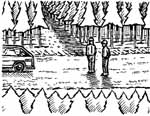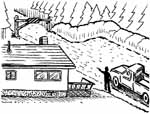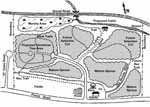Lesson Three - Choosing a General Location
Lesson One covered what roads are and why we need them. Lesson Two discussed when to build your road and who will do the work. In this Lesson, we begin to plan where to build your road and choose a general location. The exact layout of the road is determined by the terrain and environmental factors which are covered in the next Lesson.
You may already have a good idea of where your road needs to be. It may be a case of extending or branching off from an existing road to reach a new work area. For other woodlot owners, there may be other considerations that are not so obvious. The shortest route may not always be the best. Five factors to consider at the start are reviewed below.
Exercise Two
First, make a few copies of your woodlot map including the immediate area around it. Using your collection of maps and aerial photos, draw in pencil all existing roads and trails on your woodlot. Draw in all stream and wetlands that you know of if not already on the map. Include usable routes as well as old ones. Then draw all public roads that cross or border your lot. Finally draw any roads on neighbouring woodlots that come near or up to your boundary. Some research on the ground and on the phone is recommended to make sure that you have up-to-date information.
Going back to your objectives in Lesson One, circle the area(s) that you want to reach.
One : Extension or upgrade of existing roads on your woodlot
Look at the existing road system on your map. Does it meet your immediate objective? If so, what is the condition of the road? Does it need to be upgraded? Is it practical to extend it or branch off to the planned work area? Can all or part of it be used or should it be retired? Sometimes, going from an old, low standard trail to a good quality, long-term forest access road can cost as much or more than a completely new road in a better location.
Two: Using nearby roads
Building a long road is expensive and may not always be necessary if the area being harvested is close to an existing public road. It may be cheaper to build a short road in from the public road rather than a long one extending from another part of your land. Is this an option for you? An approval from the Nova Scotia Department of Transportation and Public Works (DOTPW) is required to connect a private road to a public road. Adequate sighting distances and night visibility are necessary. Contact your local DOTPC office.
 |
|
One option for accessing your woodlot may be to use a neighbouring road.
|
If the area you want to reach is close to a neighbour's woodlot road, you may want to consider asking your neighbour for a legal right-of-way. It may come with a price. Make sure your neighbour's road is adequate for your proposed use and will continue to be. Another option for two or more neighbours that need a road is to cooperate in building one that extends across each property. This is called a common road and is generally a class "C" or better.
If you don't know who owns the land, information on land ownership can be obtained from the Land Information Centres (Appendix B). Information on getting a legal right-of-way across Crown Land can be obtained from the Land Administration Branch of NSDNR at 424-4267.
Three: Security
Building and upgrading roads and trails means easier access to the woods and this may attract more people to your woodlot for recreational use. This brings up three issues: privacy, liability and vandalism.
If privacy is important to you, you may want to install gates and No Trespassing signs. Be aware, however, that the public do have the right to use unmanaged, private, forested land for recreational purposes in Nova Scotia under Protection of Property Act, Section 15. The landowner can sue, however, under Common Law for unlawful entry.
More visitors also means more potential liability to the landowner. Liability refers to your responsibility if anyone gets hurt. As a landowner, you have various responsibilities to the visitor depending on the nature of their visit as listed in the chart below. For more information on trespassing and liability, see Module Nine, Woodlot Recreation, Lesson Five.
| Visitor | Occupier's responsibility |
|
Trespasser On the property without permission |
Occupier Must not act intentionally to cause harm to visitor or act with reckless disregard for the safety of the visitor. |
|
Licensee On the property with permission but no benefit to occupier |
Occupier Must take reasonable measures to protect visitor from hidden or unusual dangers that occupier knows of. |
|
Invitee On the property with permission and of benefit to landowner |
Occupier Same as above plus dangers occupier ought to know of |
Garbage dumping and destruction to buildings and equipment may also become an issue if access to your property is improved. A growing problem is the cutting and theft of valuable trees. Again installing gates and No Trespassing signs may be helpful. Gates should be well marked with luminous reflectors and there should also be signs ahead sometimes from both directions warning of the gate.
 |
|
Locating your woodlot road close to your house can provide more security.
|
These issues may affect where you decide to locate your road. If security is a major concern for you, you may want to design your road system so there is only one entrance for vehicles. If you live on your woodlot, you may want to locate that access next to your home.
Four: Long-term objectives
Review your long-term objectives that may require more road and trail networks in the future. Some of these may be five, ten or even twenty years ahead. Make a note of these future needs. Locate them on your map in a different colour. Considering long-term as well as immediate objectives may change your road location.
Five: Terrain
Terrain is a big factor in the layout of your road (next Lesson) but it may also be a factor in choosing a general location. Try to avoid areas that have steep hills and gulches, large rock outcrops, wetlands, and poor soil drainage.
Example
The MacDonald family recently bought a 150 ha (370 acre) woodlot where they now live (see map). The lot is an old farmstead with 10 ha of cleared fields, a .5 km old woods road and a network of old trails. Some of the land is mature spruce that grew up in the fields. The lot has some stands of mixed woods that would be good for selection cutting of sawlogs and firewood. There is a large area suitable for Christmas trees.
 |
|
The MacDonald woodlot
|
Their immediate objective is to develop a Christmas tree lot. In the future, they would also like to build a camp on the back of their land. Another long-term objective is to have a network of trails suitable for cross country skiing and horseback riding.
To meet their objectives, they get familiar with the entire lot at various seasons and locate all existing roads and trails and wetlands on a map. The short, unused road is not close to the proposed Christmas tree area. A public road to the north provides closer access, but there is a large marsh in the area. A neighbour's Class "D" road comes even closer, but they realise that a Christmas tree operation requires frequent visits and decide not to rely on a right-of-way road.
They consider building a road directly in from the paved road to the south but have some concerns about security. They do not mind people using their woodlot for recreation but they are very concerned about vandalism and tree theft. They decide to build a new road that begins next to their house to have some control over who is entering their woodlot. This requires a long 1.5 km road back to the Christmas tree area, but the road will service branch roads in the future for skiing and riding.
Exercise Three
Looking at your map, consider each of these five factors as it relates to your woodlot. It may be necessary to get more information. Do these factors affect where your road will be located?